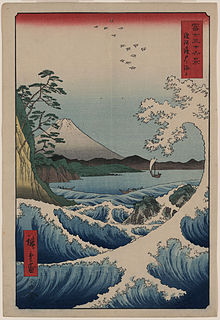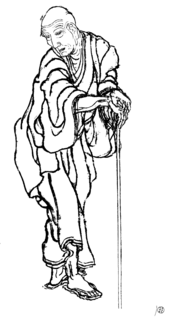
Katsushika Hokusai was a Japanese artist, ukiyo-e painter and printmaker of the Edo period. Born in Edo, Hokusai is best known as author of the woodblock print series Thirty-six Views of Mount Fuji which includes the internationally iconic print, The Great Wave off Kanagawa.
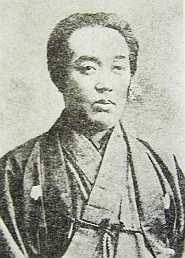
Tsukioka Yoshitoshi was a Japanese artist.

Hasui Kawase was a Japanese artist. He was one of the most prominent print designers of the shin-hanga movement.

Utagawa Hiroshige, born Andō Hiroshige, was a Japanese ukiyo-e artist, considered the last great master of that tradition.
The Fifty-Three Stations of the Tōkaidō, in the Hōeidō edition (1833–1834), is a series of ukiyo-e woodcut prints created by Utagawa Hiroshige after his first travel along the Tōkaidō in 1832.
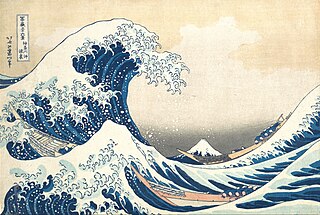
The Great Wave off Kanagawa, also known as The Great Wave or simply The Wave, is a woodblock print by the Japanese ukiyo-e artist Hokusai. It was published sometime between 1829 and 1833 in the late Edo period as the first print in Hokusai's series Thirty-six Views of Mount Fuji. It is Hokusai's most famous work, and one of the most recognizable works of Japanese art in the world.
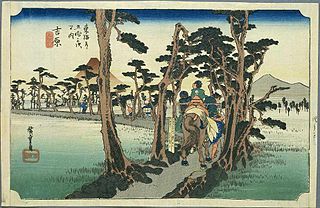
Yoshiwara-juku was the fourteenth of the fifty-three stations of the Tōkaidō. It is located in the present-day city of Fuji, Shizuoka Prefecture, Japan.
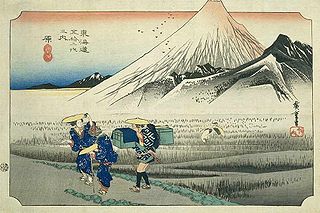
Hara-juku was the thirteenth of the fifty-three stations of the Tōkaidō. It is located in the present-day city of Numazu, Shizuoka Prefecture, Japan.

Hiroshige II was a Japanese designer of ukiyo-e art. He inherited the name Hiroshige II following the death in 1858 of his master Hiroshige, whose daughter he married. In 1865 he moved from Edo to Yokohama after dissolving his marriage and began using the name Kisai Risshō. His work so resembles that of his master that scholars have often confused them.
The term aizuri-e usually refers to Japanese woodblock prints that are printed entirely or predominantly in blue. When a second color is used, it is usually red. Even if only a single type of blue ink was used, variations in lightness and darkness (value) could be achieved by superimposing multiple printings of parts of the design or by the application of a gradation of ink to the wooden printing block (bokashi).

Bokashi is a technique used in Japanese woodblock printmaking. It achieves a variation in lightness and darkness (value) of a single color or multiple colors by hand applying a gradation of ink to a moistened wooden printing block, rather than inking the block uniformly. This hand-application had to be repeated for each sheet of paper that was printed.

The Eight Views of Ōmi are traditional scenic views of Ōmi Province which is now Shiga Prefecture in Japan.

Moving Mountains is the second album by The Casket Lottery. The cover and insert images are from Katsushika Hokusai's woodblock prints from his Thirty-six Views of Mount Fuji series.

One Hundred Famous Views of Edo is a series of ukiyo-e prints begun and largely completed by the Japanese artist Hiroshige (1797–1858). The prints were first published in serialized form in 1856–59, with Hiroshige II completing the series after Hiroshige's death. It was tremendously popular and much reprinted.

Fine Wind, Clear Morning, also known as South Wind, Clear Sky or Red Fuji, is a wood block print by Japanese artist Hokusai (1760–1849), part of his Thirty-six Views of Mount Fuji series, dating from c. 1830 to 1832. The work has been described as "one of the simplest and at the same time one of the most outstanding of all Japanese prints".
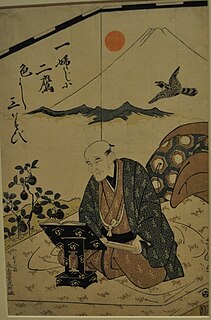
Nishimuraya Yohachi was one of the leading publishers of woodblock prints in late 18th Japan. He founded the Nishimuraya Yohachi publishing house, also known as Nishiyo (西与), which operated in Nihonbashi's Bakurochō Nichōme under the shop name Eijudō. The firm's exact dates are unclear, but many art historians date its activity to between c. 1751 and 1860.

Sundai, Edo is a woodblock print by the Japanese ukiyo-e artist Hokusai. It was produced as the fifth print in the series Thirty-six Views of Mount Fuji from c. 1830 to 1832 in the late Edo period.

A View of Mount Fuji Across Lake Suwa is a woodblock print by the Japanese ukiyo-e artist Hokusai.
This page is based on this
Wikipedia article Text is available under the
CC BY-SA 4.0 license; additional terms may apply.
Images, videos and audio are available under their respective licenses.

